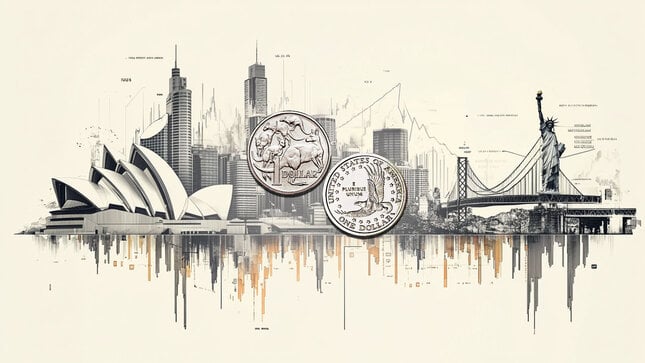- Indian Rupee edges lower despite the softer USD.
- The Reserve Bank of India (RBI) pushed back against the IMF, saying the intervention in the currency market was excessive.
- Q3 US GDP growth, Core Personal Consumption Expenditures Price Index (PCE) will be closely watched this week.
Indian Rupee (INR) trades on a softer note on Wednesday despite the weaker US Dollar (USD) and the US Treasury bond yields. The International Monetary Fund (IMF) noted in its annual Article IV review that the USD/INR exchange rate moved within a very narrow range from December 2022 to October 2023, suggesting that the Reserve Bank of India’s (RBI) foreign exchange intervention likely exceeded levels necessary to manage market conditions.
The Indian central bank strongly disagreed with the IMF’s assessment, terming it "unjustified.” RBI Governor Shaktikanta Das said in October that currency market interventions should not be seen as black-and-white. The IMF suggested a flexible exchange rate as the first line of defense against external shocks and forecast the Indian economy to grow at 6.3% for the current fiscal year. The growth is expected to remain strong, underpinned by macroeconomic and financial stability.
Investors will monitor the release of US Existing Home Sales on Wednesday. Later this week, the attention will turn to the US Gross Domestic Product Annualized (Q3), due on Thursday. The annual growth number is estimated to remain steady at 5.2%. On Friday, the Fed’s preferred inflation gauge, as measured by the Core Personal Consumption Expenditures Price Index (PCE) will be in the spotlight.
Daily Digest Market Movers: Indian Rupee stays on the soft side amid the multiple headwinds
- The International Monetary Fund (IMF) has reclassified India's exchange rate regime to a stabilized arrangement from floating.
- RBI policymakers said the central bank doesn't target a level for the Indian Rupee but rather intervenes to mitigate volatility in the currency market.
- According to the IMF, India is estimated to contribute over 16% of global growth as economic reforms in key sectors such as infrastructure and digitalization have pushed India to be a "star performer" among nations.
- According to National Securities Depository Ltd., foreign investors purchased more than $1 billion in Indian shares on Friday, after making $1.5 billion in purchases in the first four days of the week.
- India's foreign currency reserves increased by $2.816 billion in the week ended December 8 to a four-month high of $606.859 billion, according to the RBI.
- The US Building Permits dropped to 1.46M in November from 1.498M in October, weaker than the market expectation of 1.47M. Housing Starts for November rose to 1.56M from 1.359M, above the market consensus of 1.36M.
Technical Analysis: Indian Rupee sticks to the longer-term range theme
The Indian Rupee continues to trade on the weak side on the day. The USD/INR pair has traded within a multi-month trading band of 82.80–83.40. According to the daily chart, USD/INRholds above the key 100-day Exponential Moving Average (EMA). Nonetheless, further tests of the key EMA cannot be ruled out as the 14-day Relative Strength Index (RSI) stands below the 50.0 midline.
Any follow-through selling below the 83.00 psychological level will see a drop to the confluence of the lower limit of the trading range and a low of September 12 at 82.80. A decisive break below 82.80 will trigger the possibility of a short-term downmove to a low of August 11 at 82.60. On the flip side, A breakout above the upper boundary of the trading range at 83.40 could pave the way to the year-to-date (YTD) high of 83.47, followed by the psychological round mark of 84.00.
US Dollar price this week
The table below shows the percentage change of US Dollar (USD) against listed major currencies this week. US Dollar was the strongest against the Japanese Yen.
| USD | EUR | GBP | CAD | AUD | JPY | NZD | CHF | |
| USD | -0.56% | -0.33% | -0.24% | -1.01% | 0.97% | -1.05% | -1.07% | |
| EUR | 0.57% | 0.25% | 0.35% | -0.42% | 1.55% | -0.45% | -0.50% | |
| GBP | 0.33% | -0.23% | 0.09% | -0.68% | 1.30% | -0.71% | -0.74% | |
| CAD | 0.23% | -0.38% | -0.10% | -0.78% | 1.20% | -0.81% | -0.85% | |
| AUD | 1.00% | 0.42% | 0.67% | 0.77% | 1.96% | -0.03% | -0.08% | |
| JPY | -0.98% | -1.58% | -1.30% | -1.20% | -2.01% | -2.06% | -2.08% | |
| NZD | 1.03% | 0.47% | 0.70% | 0.80% | 0.03% | 1.99% | -0.03% | |
| CHF | 1.06% | 0.49% | 0.74% | 0.84% | 0.07% | 2.03% | 0.04% |
The heat map shows percentage changes of major currencies against each other. The base currency is picked from the left column, while the quote currency is picked from the top row. For example, if you pick the Euro from the left column and move along the horizontal line to the Japanese Yen, the percentage change displayed in the box will represent EUR (base)/JPY (quote).
Indian Rupee FAQs
What are the key factors driving the Indian Rupee?
The Indian Rupee (INR) is one of the most sensitive currencies to external factors. The price of Crude Oil (the country is highly dependent on imported Oil), the value of the US Dollar – most trade is conducted in USD – and the level of foreign investment, are all influential. Direct intervention by the Reserve Bank of India (RBI) in FX markets to keep the exchange rate stable, as well as the level of interest rates set by the RBI, are further major influencing factors on the Rupee.
How do the decisions of the Reserve Bank of India impact the Indian Rupee?
The Reserve Bank of India (RBI) actively intervenes in forex markets to maintain a stable exchange rate, to help facilitate trade. In addition, the RBI tries to maintain the inflation rate at its 4% target by adjusting interest rates. Higher interest rates usually strengthen the Rupee. This is due to the role of the ‘carry trade’ in which investors borrow in countries with lower interest rates so as to place their money in countries’ offering relatively higher interest rates and profit from the difference.
What macroeconomic factors influence the value of the Indian Rupee?
Macroeconomic factors that influence the value of the Rupee include inflation, interest rates, the economic growth rate (GDP), the balance of trade, and inflows from foreign investment. A higher growth rate can lead to more overseas investment, pushing up demand for the Rupee. A less negative balance of trade will eventually lead to a stronger Rupee. Higher interest rates, especially real rates (interest rates less inflation) are also positive for the Rupee. A risk-on environment can lead to greater inflows of Foreign Direct and Indirect Investment (FDI and FII), which also benefit the Rupee.
How does inflation impact the Indian Rupee?
Higher inflation, particularly, if it is comparatively higher than India’s peers, is generally negative for the currency as it reflects devaluation through oversupply. Inflation also increases the cost of exports, leading to more Rupees being sold to purchase foreign imports, which is Rupee-negative. At the same time, higher inflation usually leads to the Reserve Bank of India (RBI) raising interest rates and this can be positive for the Rupee, due to increased demand from international investors. The opposite effect is true of lower inflation.
Information on these pages contains forward-looking statements that involve risks and uncertainties. Markets and instruments profiled on this page are for informational purposes only and should not in any way come across as a recommendation to buy or sell in these assets. You should do your own thorough research before making any investment decisions. FXStreet does not in any way guarantee that this information is free from mistakes, errors, or material misstatements. It also does not guarantee that this information is of a timely nature. Investing in Open Markets involves a great deal of risk, including the loss of all or a portion of your investment, as well as emotional distress. All risks, losses and costs associated with investing, including total loss of principal, are your responsibility. The views and opinions expressed in this article are those of the authors and do not necessarily reflect the official policy or position of FXStreet nor its advertisers. The author will not be held responsible for information that is found at the end of links posted on this page.
If not otherwise explicitly mentioned in the body of the article, at the time of writing, the author has no position in any stock mentioned in this article and no business relationship with any company mentioned. The author has not received compensation for writing this article, other than from FXStreet.
FXStreet and the author do not provide personalized recommendations. The author makes no representations as to the accuracy, completeness, or suitability of this information. FXStreet and the author will not be liable for any errors, omissions or any losses, injuries or damages arising from this information and its display or use. Errors and omissions excepted.
The author and FXStreet are not registered investment advisors and nothing in this article is intended to be investment advice.
Recommended content
Editors’ Picks

Gold price extends fresh record run toward $3,500
Gold price continues to build on its record rally, closing in on the $3,500 mark in Asian trading on Tuesday. Investors continue to flock to safety in the traditional store of value, the Gold price, amid no confidence in the US Dollar and Trump’s attacks on Fed Chairman Powell.

AUD/USD bounces back toward 0.6450 as US Dollar resumes downside
AUD/USD picks up fresh bids toward 0.6450 in the Asian session on Tuesday. The US Dollar fizzles its bounce and resumes downside amid uncertainty over Trump's trade policies and the weakening confidence in the US economy. Concerns about the rapidly escalating US-China trade war could act as a headwind for the Aussie.

USD/JPY mires in multi-month low near 140.00
USD/JPY languishes in seven-month lows near 140.00 in the Asian session on Tuesday. Trade war concerns, global recession fears, hopes for a US-Japan trade deal, and the divergent BoJ-Fed bets could continue to underpin the Japanese Yen while the US Dollar selling resumes.

Stacks soars 20% as BTC surpasses $88,000
Stacks price is extending its gains by 9%, trading around $0.76 at the time of writing on Tuesday following a 10% rally the previous day. On-chain data paints a bullish picture as STX open interest and trading volume are rising.

Five fundamentals for the week: Traders confront the trade war, important surveys, key Fed speech Premium
Will the US strike a trade deal with Japan? That would be positive progress. However, recent developments are not that positive, and there's only one certainty: headlines will dominate markets. Fresh US economic data is also of interest.

The Best brokers to trade EUR/USD
SPONSORED Discover the top brokers for trading EUR/USD in 2025. Our list features brokers with competitive spreads, fast execution, and powerful platforms. Whether you're a beginner or an expert, find the right partner to navigate the dynamic Forex market.



